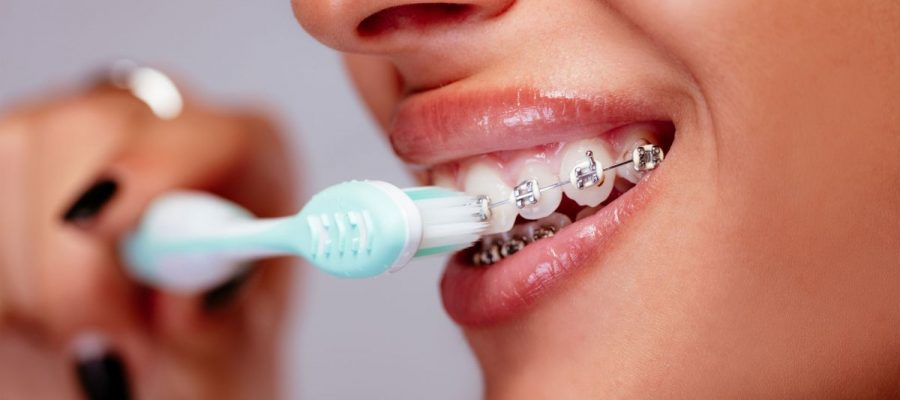Can you use an electric toothbrush with braces? Once a rite of passage for the awkward teenager, braces are increasingly furnishing the mouths of adults – including Hollywood celebrities – in their quest for the picture-perfect smile. To ensure we achieve the perfect set of pearly whites, brushing and flossing are an important part of the daily routine. In recent years, dentists have been recommending an electric toothbrush over a manual toothbrush as they provide a better clean.
Whether they’re traditional braces, self-ligating braces (which are a bit like traditional braces but more discrete), or lingual braces attached to the underside of your teeth, cleaning around the brackets fixed to your teeth and under the wire is vital. Proper cleaning will prevent a build-up of food particles and plaque, which contains the bacteria that cause dental decay and gum disease.
We explore whether an electric toothbrush is better than manual brushing if you have braces, what proper brushing technique is and how often you should brush your teeth with braces. And if you want to expand your dental repertoire even further, check out our handy guides on how to floss your teeth and how often should you floss. You can even find reviews of some of the best electric toothbrushes right here at LiveScience.
- Related: Oral B vs Sonicare – Which toothbrush is better?
Can you use an electric toothbrush with braces: is it better to use a manual toothbrush with braces?
The American Dental Association (ADA) advises that you brush your teeth twice a day with fluoride toothpaste and a soft bristled brush that is the right size and shape for your mouth to enable you to reach all those tricky spots. But is it better to use a manual or electric toothbrush with braces?
Manual brushing is sufficient if you do it properly, but electric toothbrushes have a rotating, oscillating head which makes the process easier, faster and more effective, especially with braces.
Can you use an electric toothbrush with braces?
“I always advocate using an electric toothbrush where possible as they can improve the efficacy of brushing just because of the amount of bristle movement you can achieve in a short space of time,” Cat Edney, a dental hygienist and therapist, told LiveScience.
When brushing with a manual toothbrush, you can achieve around 300 strokes a minute, but with a standard electric toothbrush this increases to anything between 2,500 and 7,500 strokes per minute.
Sonic electric toothbrushes are even better; these vibrate at a high frequency and have a fast-moving brush to reach speeds of 30,000 strokes per minute – or more. They are ideal for braces as they can clean food and bacteria trapped around the brackets and under wires, and research from the The International Journal of Periodontics & Restorative Dentistry suggests sonic electric toothbrushes are better at removing plaque and reducing gum inflammation than manual toothbrushing.
Electric and sonic electric toothbrushes can be used with any type of brace, effectively cleaning around the wires and brackets without causing any damage. Research from the journal Evidence-Based Dentistry confirms they are better at removing plaque than manual brushing, and those that are fitted with handy timers let you know when you’ve reached your optimal two-minute brushing time.
- Related: Are teeth naturally yellow?
Can you use an electric toothbrush with braces? how to brush your teeth with braces
MouthHealthy, part of the ADA, advises that the proper brushing technique is to place your toothbrush at a 45-degree angle to the gums and gently move the brush back and forth in short strokes that are about tooth-width. You should brush the outer and inner surfaces, and the chewing surfaces of the teeth. You might find you need to tilt the brush vertically and make several up-and-down strokes to clean the inside surfaces of the front teeth.
The advice is the same whether you are brushing manually or with an electric toothbrush, and whether you have braces or not. But if you do have braces, you’ll have to pay particular attention to the area around the brackets and under the wires as food and bacteria like to accumulate here.
“Those wearing braces, especially the fixed type with a metal wire, may find that they need to also use a few different styles of brush in order to fully clean around all the difficult brackets and wires,” said Edney.
She recommended a single tuft brush to reach the tricky areas, and an interdental brush, which has a small, bristled head, to clean in between the teeth.
“I always remind patients that the spaces between our teeth count for around 30% of the total surface of our teeth,” said Edney. “It is vitally important that we keep them clean especially as they are in hard-to-reach areas where bacteria can stagnate if left to its own devices.”
Kerry Taylor-Smith
Kerry is a freelance writer and editor, specializing in science and health-related topics. Her work has appeared in many scientific and medical magazines and websites, including Forward, Patient, NetDoctor, YourWeather, the AZO portfolio, and NS Media titles.
Kerry’s articles cover a wide range of topics including astronomy, nanotechnology, physics, medical devices, pharmaceuticals and mental health, but she has a particular interest in environmental science, cleantech and climate change.
Kerry is NCTJ trained, and has a degree Natural Sciences from the University of Bath where she studied a range of topics, including chemistry, biology, and environmental sciences.
Source: Read Full Article


